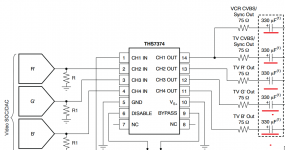No, it's not going to damage anything, even if you have the wrong cable. I've got a bunch of different cables here, some with resistor and caps, some with just caps. If you lack resistors in your cable the picture will be brighter (but you probably wouldn't even know). If the caps are missing it wont affect anything really, but the caps should be in the cable too (with regards to RGB connections). Composite tends to just pass through on all cables I've seen. People need to calm down a bit lol, one person mentions a cap issue or a problem with their setup and everyone starts thinking the end of the world is coming...
You've mentioned a few things that I would like to go through. A lot of people are interested in understanding this stuff, so I'll try to throw some data out for you all.
You mentioned the Amiga and a lot of the 30+ year old reversed caps. Well, yes. The Amiga systems did have a lot of screwy capacitors in the the audio section. Hell, the Amiga 4000's A3640 had all of its electro's installed the wrong way, almost. But you are comnparing two very different things here. Tantalum caps and Electrolytics are very different things with very different properties in their dielectrics. The question isn't "When will this destroy my shit?" the question should be "CAN this destroy my shit?"
Tantalum Capacitors that are polarized are designed to only operate under a forward voltage bias. Inverting the polarity of a Tantalum can produce nasty, high leakage currents and can possibly do some bad stuff. Don't take my word for it. Read Kemet's own white-paper on the matter.
http://www.kemet.com/Lists/TechnicalArticles/Attachments/199/2014%20EDFA%20Tantalum%20Cap%20Failure%20Analysis%20Review%20by%20Javaid%20Qazi.pdf
Maybe I am blind here but I actually don't even see the problem. The datasheet indicates the +ve side should be nearest the connector. The photo shows C60's positive side (assuming its a tant) on the side nearest the connector.
Well, C60 is the capacitor that's responsible for AC coupling composite video for termination. But what does that mean, exactly?
The THS7374 is a rail to rail amplifier. You have two rails; 0V and 5V. There's no -ve rail here. The THS7374 outputs are DC biased above 0V. So when you AC couple (add that 220uF-330uF capacitor) the video line, you'll have a DC voltage across the capacitor, which is directed towards the 7374. Meaning, like this:

See the orientation of the polarity? Ti fucked up ONE diagram in their datasheet. But if you're building up a video circuit, you shouldn't need to reference the orientation of the AC coupling capacitors. I mean, yeah. TI fucked this part up, but that's something that's super easy to catch. That's like putting a car battery in backwards. Just look at the EVAL board, and look at all of the other application notes.
At any rate, what all of this means is that this capacitor (C60) is responsible for removing any DC offset from the transmission line. The reason I'm explaining this is because if you understand this, then you'll understand why inverting the polarity on a capacitor that's AC coupling your video line is a big no no and the orientation of the offset caps shouldn't even be in question..
Now, is this going to burn down your house? Probably not. Is it going to catch fire? More than likely not. Will composite video performance suffer? Sure it will, and that's very measurable. You're going to have a steady voltage error in your coupling component (capacitor). How much will your picture quality suffer? That's hard to say. The clamping element of your Television, Scaler, or Penis pump will be what determines how well the DC "drift" is handled. It may also impact how well TV's, BVM's and Scalers slice or "lock" onto the sync signal, if you're syncing on composite video. But it's not a huge god damned deal. Just reverse the thing, if you can. Or if you don't have any intention of using composite video, piss on it. It will do you zero harm. It's not the end of the world, boiz. Absolutely definitely isn't a reason to do a unit recall. That would be fucking ridiculous.
BTW, C-Video isn't .3vPP, that's C-Sync. C-Video is a nominal 1vPP.


